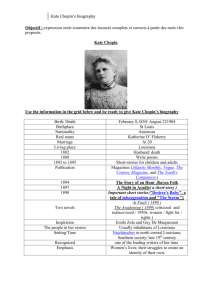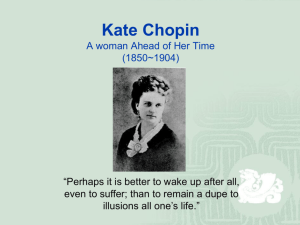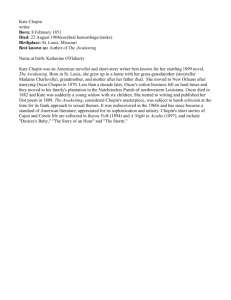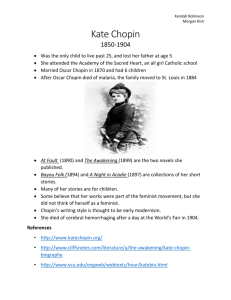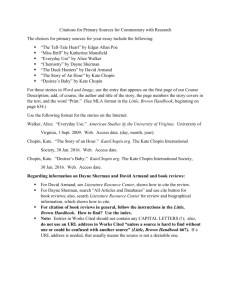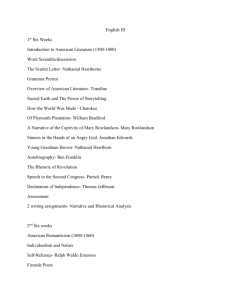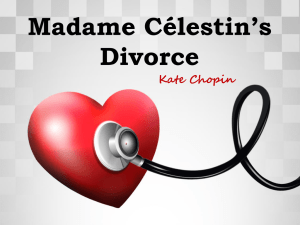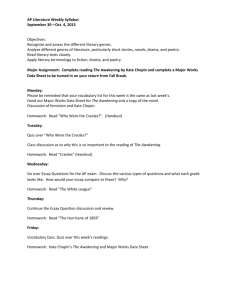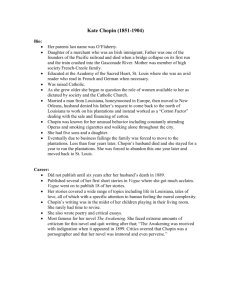Kate Chopin: Beyond Local Color to Feminism Ph.D. Candidate Florinda Boriçi
advertisement
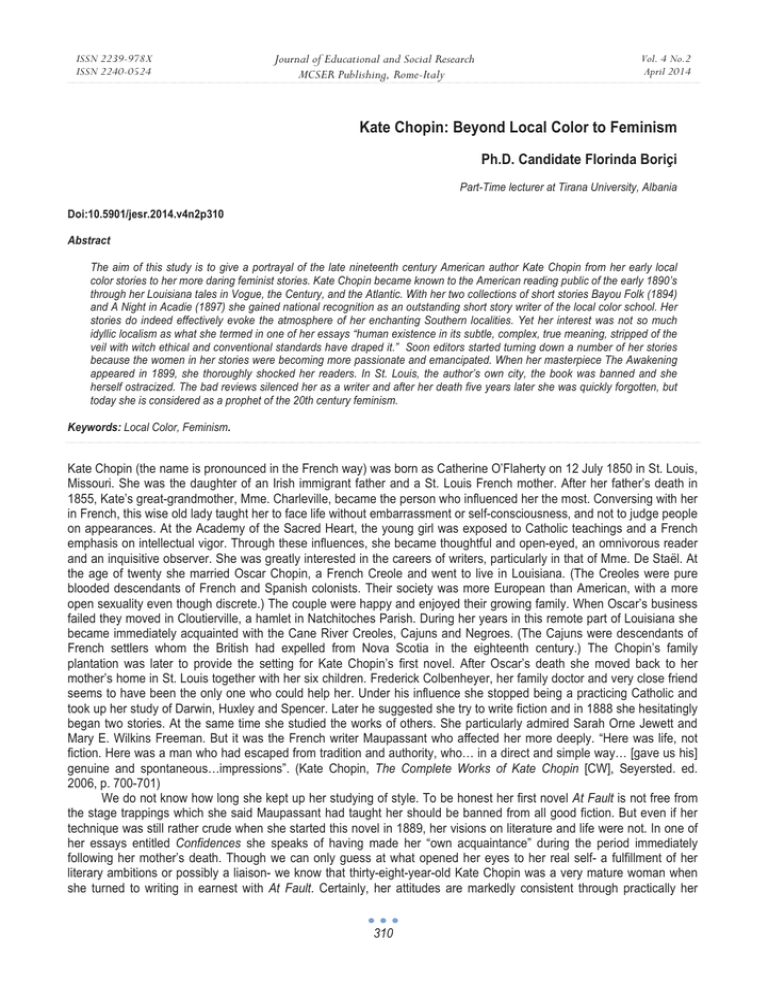
ISSN 2239-978X ISSN 2240-0524 Journal of Educational and Social Research MCSER Publishing, Rome-Italy Vol. 4 No.2 April 2014 Kate Chopin: Beyond Local Color to Feminism Ph.D. Candidate Florinda Boriçi Part-Time lecturer at Tirana University, Albania Doi:10.5901/jesr.2014.v4n2p310 Abstract The aim of this study is to give a portrayal of the late nineteenth century American author Kate Chopin from her early local color stories to her more daring feminist stories. Kate Chopin became known to the American reading public of the early 1890’s through her Louisiana tales in Vogue, the Century, and the Atlantic. With her two collections of short stories Bayou Folk (1894) and A Night in Acadie (1897) she gained national recognition as an outstanding short story writer of the local color school. Her stories do indeed effectively evoke the atmosphere of her enchanting Southern localities. Yet her interest was not so much idyllic localism as what she termed in one of her essays “human existence in its subtle, complex, true meaning, stripped of the veil with witch ethical and conventional standards have draped it.” Soon editors started turning down a number of her stories because the women in her stories were becoming more passionate and emancipated. When her masterpiece The Awakening appeared in 1899, she thoroughly shocked her readers. In St. Louis, the author’s own city, the book was banned and she herself ostracized. The bad reviews silenced her as a writer and after her death five years later she was quickly forgotten, but today she is considered as a prophet of the 20th century feminism. Keywords: Local Color, Feminism. Kate Chopin (the name is pronounced in the French way) was born as Catherine O’Flaherty on 12 July 1850 in St. Louis, Missouri. She was the daughter of an Irish immigrant father and a St. Louis French mother. After her father’s death in 1855, Kate’s great-grandmother, Mme. Charleville, became the person who influenced her the most. Conversing with her in French, this wise old lady taught her to face life without embarrassment or self-consciousness, and not to judge people on appearances. At the Academy of the Sacred Heart, the young girl was exposed to Catholic teachings and a French emphasis on intellectual vigor. Through these influences, she became thoughtful and open-eyed, an omnivorous reader and an inquisitive observer. She was greatly interested in the careers of writers, particularly in that of Mme. De Staël. At the age of twenty she married Oscar Chopin, a French Creole and went to live in Louisiana. (The Creoles were pure blooded descendants of French and Spanish colonists. Their society was more European than American, with a more open sexuality even though discrete.) The couple were happy and enjoyed their growing family. When Oscar’s business failed they moved in Cloutierville, a hamlet in Natchitoches Parish. During her years in this remote part of Louisiana she became immediately acquainted with the Cane River Creoles, Cajuns and Negroes. (The Cajuns were descendants of French settlers whom the British had expelled from Nova Scotia in the eighteenth century.) The Chopin’s family plantation was later to provide the setting for Kate Chopin’s first novel. After Oscar’s death she moved back to her mother’s home in St. Louis together with her six children. Frederick Colbenheyer, her family doctor and very close friend seems to have been the only one who could help her. Under his influence she stopped being a practicing Catholic and took up her study of Darwin, Huxley and Spencer. Later he suggested she try to write fiction and in 1888 she hesitatingly began two stories. At the same time she studied the works of others. She particularly admired Sarah Orne Jewett and Mary E. Wilkins Freeman. But it was the French writer Maupassant who affected her more deeply. “Here was life, not fiction. Here was a man who had escaped from tradition and authority, who… in a direct and simple way… [gave us his] genuine and spontaneous…impressions”. (Kate Chopin, The Complete Works of Kate Chopin [CW], Seyersted. ed. 2006, p. 700-701) We do not know how long she kept up her studying of style. To be honest her first novel At Fault is not free from the stage trappings which she said Maupassant had taught her should be banned from all good fiction. But even if her technique was still rather crude when she started this novel in 1889, her visions on literature and life were not. In one of her essays entitled Confidences she speaks of having made her “own acquaintance” during the period immediately following her mother’s death. Though we can only guess at what opened her eyes to her real self- a fulfillment of her literary ambitions or possibly a liaison- we know that thirty-eight-year-old Kate Chopin was a very mature woman when she turned to writing in earnest with At Fault. Certainly, her attitudes are markedly consistent through practically her 310 ISSN 2239-978X ISSN 2240-0524 Journal of Educational and Social Research MCSER Publishing, Rome-Italy Vol. 4 No.2 April 2014 whole oeuvre. Many of the views which informed Kate Chopin’s fiction from the start are suggested in her essays of the middle 1890s. She insisted here that no author can be true to life who refuses to pluck from the Darwinian tree of knowledge and to see human existence in its true meaning. To her nature was amoral, playing with man, and morality was man-made and relative. In her view, man is basically the same today as he has ever been, that is, ruled by imperative, immutably selfish drives. To her art was incompatible with a thesis and with a zeal for reform. “Human impulses do not change” Kate Chopin reported, and when Aeschylus is true today, one reason is that he does not deal with local color or with social problems which by their very nature are mutable.” (CW, 2006, p.693) As for herself, Kate Chopin concentrated on the immutable impulses of sex and Love, and Whitman and Maupassant were two of the authors who spoke most deeply to her, probably because they acknowledged the existence of Eros and because they had helped to extend the literary limits to the treatment of sex. Though she leaned to the French school, she believed that American writers with their “wider and more variegated field of observation” might equal and perhaps even surpass the French authors, “were it not that the limitations imposed upon their art by their environment hamper a full and spontaneous expression” (Seyersted, 1980, p.89) In May, 1889, Kate Chopin offered her first completed story to the Home Magazine. Her next two tales appeared at the end of 1889. In September, 1890, she brought out her first novel At Fault in St. Louis at her own expenses. In reviewing the novel, St. Louis critics paid tribute to the author’s style, but criticized the book on moral grounds. Stimulated by her modest success, Kate Chopin soon finished a second novel. All we know about it is that a number of publishers refused it and that she later destroyed it. She had more luck with her stories, which soon appeared locally, then in national children’s magazines, and finally -from 1893- in such well-known eastern periodicals as Vogue, the Century and the Atlantic. She reached the high point of her public success in 1894 when Bayou Folk, her first collection of short stories came out. In it were included half of the fifty tales and sketches she had then written. After the publication of Bayou Folk, Kate Chopin was welcomed in more than a hundred press notices as a distinguished local colorist. (Local Color refers to fiction that came to prominence in the USA in the late nineteenth century and was devoted to capturing the features and peculiarities of a particular locality and its inhabitants- their distinctive dialect, history and customs). The sudden national fame inspired Kate Chopin to write “The Story of an Hour”, a most remarkable account of a woman who exclaims “Free! Free! Free!” (CW, 2006, p. 353) when she hears of her husband’s sudden death. A month later Kate Chopin declared in a diary entry that she would now be willing to “forget the past ten years of [her] growth- real growth and with a new perfect acquiescence join Oscar were it possible for him to come back to earth”. The story and the diary entry suggest that Mrs. Chopin may have felt repressed in her marriage, perhaps because of an unfulfilled literary ambition, and that the success of Bayou Folk gave her a release from her frustration. What is certain is that her subsequent writings reflect an increasing self-confidence and daring. “The Story of an Hour” was refused by the editor of the Century, no doubt because he felt it lacked “ethical value”. The reason why editors now turned down a number of her stories was very likely that her women became more passionate and emancipated. The heroine of “Two Portraits”, for example, insists on giving herself “when and where she chooses” (CW, 2006, p.463). When A Night in Acadie, Kate Chopin’s second collection of short stories was published in 1897, it received less notice than its predecessor. The critics again praised her art, but they objected the sensuous ambiance of the book. By 1897, Kate Chopin had written three novels and nearly a hundred stories and sketches. A large number of her works are set in Natchitoches, which she made her special literary province, and inevitably they have many traits in common with the local color literature of her time. Discretely, yet forcefully, she evokes her particular locality with the enchanting Cane River atmosphere, the quaint idioms, and the charming idiosyncrasies of the Natchitoches people. But even though she concentrated on what was then a distant, exotic community, she never emphasized the strange or remote; and though like George W. Cable and Grace King she commanded a wealth of local material, she did not join them in focusing on old Creole days. She was concerned with the living present rather than the past, with universal rather than regional aspects of life, and the fact that she gave only a few early stories to certain Southern issues which necessarily affected her, suggests that she wanted to free her mind of them and move on to more timeless or immutable matters. Her women particularly were objectionable to the editors. Her very first, Paula Von Stoltz of “Wiser Than a God”, refuses the “labor of loving” (CW, 2006, p.45) which a man wants to impose upon her, and becomes instead a famous pianist. In thus opposing the traditional female duties and limitations. She is a female who insists on the active transcendence of a subject rather than the passive immanence of an object, on an existentialist authenticity obtained through exerting a conscious choice, giving her own laws, and making herself her own destiny. Mildred Orme of “A 311 ISSN 2239-978X ISSN 2240-0524 Journal of Educational and Social Research MCSER Publishing, Rome-Italy Vol. 4 No.2 April 2014 Shameful Affair” is another illustration of this type of woman. She rejects the role of the passive, innocent party who makes no advances in sexual relations and demands instead the responsibility of an active subject. The new force which was freed in Kate Chopin through the success of Bayou Folk is seen particularly in her heroines who live out their strong impulses. She saw and understood all aspects of the female psyche, and her particular interest was woman’s awakening to her true nature, whether traditional, emancipated, or a mixture of the two. In “Regret” she describes how the middleaged Mamzelle Aurélie all of a sudden realizes what she has missed by not having children. The heroine of “Athénaïse” is an example of the young woman who marries before she is ready. She runs away, but Cazeau, her husband, fetches her back. On the way they pass a “solitary oak-tree, with its seemingly immutable outlines, that had been a landmark for ages” (CW, 2006, p. 433) and Cazeau suddenly recalls how his father had captured Gabe, a runaway slave, near this spot. Athénaïse runs away again, but only to hurry back to her husband when she realizes that she is bearing his child. As the song comes to the bird, she is now awakened to motherhood and passionate wifehood. In spite of its “happy ending”, this tale is on a deeper level a protest against woman’s condition. Athénaïse’s realization of the futility of rebellion against a social and sacred institution” (CW, 2006, p. 431) is supported by the story’s subtle symbolism. Cazeau’s name stands for casa or chateau in which a woman lives her hemmed-in existence, and his stern manner and jangling spur stand for the authority which forces her to submission. Athénaïse is indirectly compared to a slave. Gabe then represents the Archangel Gabriel, the herald of pregnancy; and the oak tree represents marriage and motherhood, woman’s immutable destiny which makes her the tree of life. Kate Chopin returned to this subject in The Awakening, her most profound treatment of the fundamental problem of what it means to be a woman. The novel has much in common with Madame Bovary, a story which relates how the heroine, is caught in the romantic syndrome of the supposedly great noble, undivided, transcendent love, and like the other heroine, is seduced by a rake after the departure of the more decent young man who has stirred her. The crucial point is how this event affects the two women. Emma Bovary, of course, continues her selfdramatization, tying to confirm to models and gaining little insight into her own nature as she more and more frenetically attempts to escape her dull environment. Whereas Edna Pontellier, the heroine of The Awakening, has awakened in full to an imperative craving for sex, for independence and for clarity and self-knowledge. For her, all return to past submission and all continuation of self-delusion is impossible. Instead of blaming the rake she accepts her animalism, feeling neither shame nor remorse. She realizes that sex is largely independent of our volition. And just as Edna makes no attempt to suppress her sexual desire, she does not hesitate to throw off her traditional duties towards her family. She realizes she is unable to live as the inessential adjunct to a man, as the object over which man rules. “I give myself where I choose,” (CW, 2006, p.992) she declares when Robert, her young man, suggests he might ask her husband to set her free. What she craves to be is an independent subject, to dictate her own destiny. “I would give up the inessential, I would give my money, I would give my life for my children; but I wouldn’t give myself” (CW, 2006, p. 929) Edna explains to her friend. In other words, it is less important for her to live than to have a self, to be able to exert a conscious choice which can bring out her own essence. Edna thus believes that she can direct her own life. But she comes to acknowledge a responsibility towards her children to spare them the stigma her kind of life would attach to them. Seeing that we are pawns in the hands of procreational nature, and how patriarchal society condemns particularly a freedom-seeking woman who neglects her children, she inevitably finds her power to dictate her own life to be illusory. Wanting her own way at all cost, she chooses the supreme exertion of her freedom: she takes her own life. Mrs. Pontellier’s defeat lies in the fact that she cannot integrate her demands with those of society. Her victory is her awakening to consciousness and authenticity. Earlier she had “wanted to swim far out, where no woman has swum before.” (CW, 2006, p. 893) Now she swims to her death, thinking of the clanging spurs of an officer who had attracted her, the emblem of male dominance, and of the bees humming along the pinks, the symbol of procreation. Nature and man dictate the life of the woman, and independence is much harder to obtain and much more of course for her than for the man, because she is handicapped by biology and because she must justify an untraditional existence against the heaviest possible odds. When Kate Chopin’s novel about the sensuous, independent Edna was accepted by a publisher in the early summer of 1898, the author must have felt she could do anything. Such a feeling seems to have inspired “The Storm,” which is a first-rate short story, and so daring that she never tried to publish it. That she here deals with sex even more unreservedly than Flaubert or Zola is only a minor point compared to the fact that she depicted it as “happy”- not frantic as it is in parts of Madame Bovary or destructive as in Nana, but as something as natural and beautiful as life itself. There is a cosmic exuberance and a mystic contact with the elements in “The Storm” which, together with its frankness, foreshadow D.H. Lawrence. 312 ISSN 2239-978X ISSN 2240-0524 Journal of Educational and Social Research MCSER Publishing, Rome-Italy Vol. 4 No.2 April 2014 The Awakening was published on April 22, 1899. It was immediately condemned all over America. While the critics called the novel a brilliant piece of writing, they violently attacked it on moral grounds. The novel was taken out of circulation at the St. Louis libraries, and Mrs. Chopin was shunned by some of her friends and denied membership in a local arts club. When her third collection of stories was turned down by her publisher a few months later, she evidently felt herself a literary outcast, and her writing, which had slowed down after The Awakening, was soon to cease altogether. Kate Chopin today is highly praised not only as an outstanding local colorist but also as a predecessor of the twentieth century feminism, because she was the first woman writer in America to accept sex with its profound repercussions as a legitimate subject for serious fiction. In her attitude towards passion, she represented a healthy, matter-of-fact acceptance of the whole of man. She was familiar with the newest developments in science and in world literature, and her aim was to describe – unhampered by tradition and authority- man’s immutable impulses. Because she was vigorous, intelligent, and eminently sane, and because her background had made her morally tolerant and socially secure, she could write with a balance and maturity, a warmth and humor not often found in her contemporaries. Mrs. Chopin was influenced by the feminism of Madame de Staël and George Sand and the realism of Flaubert and Maupassant. Yet she is independent and original. She turns to aspects of the feminine condition which were taboo to the two women and of little interest to the two men, even introducing an existentialist philosophy which foreshadows Simone de Beauvoir. Though she describes many women who are perfectly happy in conventional marriage, she has a number of heroines who demand freedom and an authentic existence. Kate Chopin was too much of a pioneer to be accepted in her time and place. She lived and wrote approximately three quarters of a century before her time. So long as she confined her work to innocuous local-color stories, her contemporaries accepted her work and indeed praised it. But when she dared to expose the conflicts raging inside of wives and mothers, her contemporaries insulted her personally and, even worse, banned her novel. Today, however, Chopin’s reputation stands high. Critics have found in her work traces of romanticism, realism, naturalism, existentialism and feminism. Actually, however, Kate Chopin stands alone, a solitary figure among all those “ism’s”. Clearly Flaubert and especially Maupassant influenced her. Certainly Hawthorne, Melville, Poe, Emerson, and most importantly Whitman helped to shape her responses to life. Undoubtedly, her works contain traces of the romantic, transcendental, localcolor, realistic and naturalistic movements. But Kate Chopin transcends her sources and influences to create a body of work that speaks in its own voice. That voice represents the plea of the twentieth century feminism. References Chopin, Kate, (2006) The Complete Works of Kate Chopin, ed. Per Seyersted, Baton Rouge, La.: Louisiana state University Press Seyersted, Per (ed), (1990), Kate Chopin: A Critical Biography, Baton Rouge, La.: Louisiana state University Press 313

